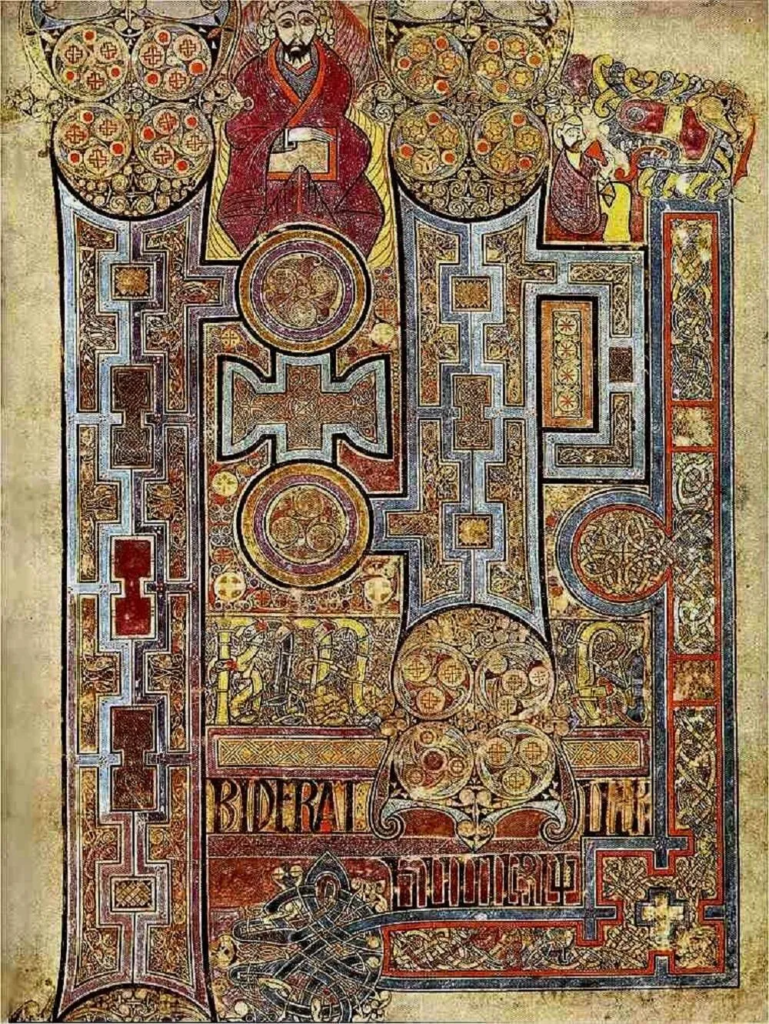
A favourite old book of mine from my childhood is Kenneth Clark’s Civilisation, which goes along with his television series. It is old-school history of western civilisation, observant and wise. In his first chapter he travels to those monasteries around Ireland and Great Britain – Skellig Michael, Iona, Lindisfarne (pictured above) – where in the sixth and seventh centuries monks were able to preserve and to create great works of writing and art, saving them from the Viking invaders. The Vikings possessed great energy and courage, and technical skill – their ships are marvels of engineering – but Clark does not see them as representing a civilisation as such, lacking the “sense of permanence” a civilisation requires. The monks did not have the Vikings’ fighting power, but they had something else, that survives to this day.
In the Washington Post this week cultural critic Philip Kennicott (gift link) also begins his essay with memories of Lindisfarne, though in his case he wants to draw a link to the future of art in America in the second Trump administration.
There are two ways to approach this. One is to look at artists who, in the first go around, chose to make art that directly addressed the White House: Jennifer Rubell’s performance piece “Ivanka Vacuuming”; Dana Schutz’s painting “Trump Descending an Escalator”; the gold-plated toilet by Maurizio Cattelan, offered to Trump by the Guggenheim Museum in an effort at humour. In terms of newsworthiness at the time, I might have added the Central Park production of “Julius Caesar” that presented a Trump-like figure in the title role.
None of these succeed: Ivanka Trump is a minor figure in the grand picture of the impact of her father, already forgotten; Schutz’s painting expresses nothing of interest; that the Guggenheim possessed the gold-plated toilet in the first place tells us much more about that institution than about Trump; and, as if this needs saying, Trump is no Julius Caesar. None of these pieces rank as interesting art or interesting political commentary. And I don’t think it is possible to create a work of art that can capture something insightful about the dreadful state of American politics. Maybe there is a work of fiction that will emerge, though my prediction is that the dust would first need to settle, maybe in 2044 or so.
The other way to approach this, which Kennicott hints at, is to preserve what is valuable in art and artistic creation even in the presence of such noise and distraction, from the barbarians and from the reactions to them. I see this as the only way forward, though even here Kennicott presents the issue in terms of “struggle” and “resistance”.
“I’m most worried that this country is not what I thought it was, but someplace much more cruel and nasty and selfish,” wrote Ruth Marcus, one of The Post opinion section’s lead political commentators, after Trump’s reelection. She echoed a sentiment expressed by other pundits, and many ordinary Americans. Most art critics probably feel the same way, but with an even sharper edge. You don’t struggle to make a career writing about the arts without believing absolutely in the power of art to make the world a better place, to make people better, to do all those morally redemptive things on the long list cited above.
In an earlier age, art served power, and many arts institutions today are too closely allied with power. But most of the larger art world, including many of the performing arts, literature and the fine arts, have been in the “resistance” since long before the term took on its current meaning.
They resist meaninglessness and absurdity, naked power and raw destruction. They make and do things to keep darkness at bay, to create spaces where the “lion griefs” nuzzle rather than consume us (to paraphrase W.H. Auden’s extraordinary image).
I don’t think art makes people better, or that it is morally redemptive. But the artist does give something of irreplaceable value. In 1939, an even more fraught time than this, in Scrutiny, Michael Oakeshott, when asked about the claims of politics on art (I once wrote an article about this) answered:
To ask the poet and the artist to provide a programme for political or other social action, or an incentive or an inspiration for such action, is to require them to be false to their own genius and to deprive society of a necessary service. What they provide is action itself, but in another and deeper sphere of consciousness. It is not their business to suggest a political remedy for political defects, but to provide an actual remedy for more fundamental defects by making society conscious of its own character. The emotional and intellectual integrity and insight for which they stand is something foreign to the political world, foreign not merely in fact, but in essence. This integrity and insight cannot be introduced into that world without changing their character; and to attempt to introduce them makes a chaos of what is otherwise a restricted but nevertheless ordered view. It is not their business to come out of a retreat, bringing with them some superior wisdom, and enter the world of political activity, but to stay where they are, remain true to their genius, which is to mitigate a little their society’s ignorance of itself.
In other words, it’s not just that attempts to address Trump through art are almost universally unsuccessful, but that there is, as we economists say, an opportunity cost – we lose something of art actually can do, “making us conscious of our own character”, so to speak.
We are not grateful to the monasteries of the dark ages for their anti-Viking art; its the Book of Kells we line up to see.

cross-posted at Substack: https://michaelrushton.substack.com/

Leave a Reply